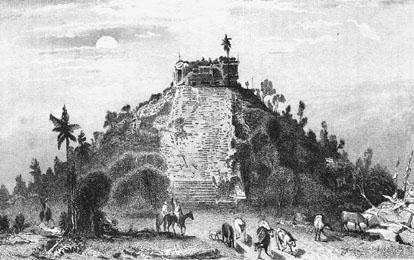

 | Page 282 |  |
of traveling in Central America at this time were enormous—it was the rainy season and the jungle had overgrown known sites. Catherwood and Stephens made their way to Copan, where Indians were hired to clear vegetation off stelae. This done, Catherwood, his ankles in mud and continually bitten by mosquitoes, began to record the complex art of an unknown civilization on damp paper. He and Stephens found fifty pieces of sculpture during the first two hours of exploring Copan, and they were to spend months surveying and recording the site with a compass and tape. Stephens’s vivid written descriptions were well matched by Catherwood’s painstaking drawings of stelae, sculpture, and architectural details. Catherwood’s plan of the site of Copan was so good that it remained the authoritative source for the next fifty years.

A drawing by Frederick Catherwood of El Castillo pyramid from Chichén Itzá,Yucatán, Mexico
(Dover Pictorial Archive)
Catherwood and Stephens decided to visit the site of palenque on their way back to the United States via mexico. They were undeterred by the fact that this site was a thousand miles away from Copan, that no one had ever traveled to it via Guatemala City, that the Yucatán was in state of civil war, that the local inhabitants were hostile, and that it was, once again, the rainy season. Their effort was rewarded by the magnificence of the ruins. Once again conditions were appalling and they were both ill, but Catherwood’s recordings of the palace, its bas-reliefs, and its hieroglyphics were outstanding. The two traveled on to the site of Uxmal, at which they could only spend a few days due to exhaustion and illness. Indeed Catherwood was only well enough to draw for one day and had to be carried to the coast on a litter. They returned to New York after ten months of traveling, and on June 25, 1841, Incidents of Travel in Central America, Chiapas and Yucatán was published to great interest and acclaim.
Fifteen months later Stephens and Catherwood returned to the Yucatán once again. Catherwood brought with him the new daguerrotype apparatus and he and Stephens spent two months at Uxmal mapping, surveying, and drawing. After this they traveled via the wells of Bolonchen to chichén itzá and then on to Cozumel and Tulum, once again mapping, surveying, and drawing, and returned to New York in 1842. Incidents of Travel in the Yucatán was published nine months later, and was also an outstanding
 |  |